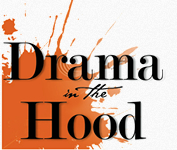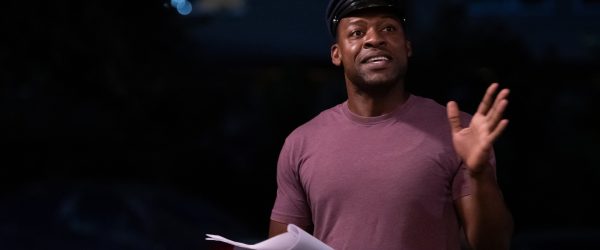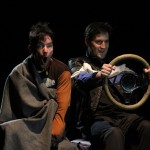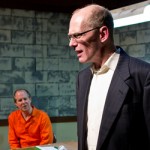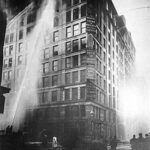William Saroyan once described his 1939 award winning play, “The Time of Your Life” as “a circus, an essay, a vaudeville…a comedy, a tragedy, a lecture—anything you want it to be. It was way out there, radical and all over the map for its time.” Saroyan’s spirit should be smiling broadly over the wild shenanigans conjured up by director Ryan Guzzo Purcell and the Williams Project for its production of his work currently on display at the Washington Hall. In his program notes Purcell explains that he wants to “blow some dust off, find what remains and make room for something new” for this American classic. You really should see for yourself how successfully the director and his team meet their dramatic goals.
The Williams Project team is coupling Saroyan’s classic with Tennessee Williams’ “Small Craft Warnings”. Mark Douglass has posted his review of that play elsewhere on our site. The two works both take place in a living, virtual bar. Good drinks and food are available throughout the evening. Audience members are invited to sit at some of the tables placed around the hall and join the actors, but must follow established burlesque rules: Actors won’t touch you, don’t touch them! Other audience members line the walls of the old building, creating a silent jury witnessing the trials and tribulations of the patrons of Nick’s Saloon. When Tina Landau directed the play in 2002, she envisioned the bar as “a place for people to meet, to debate, to rest, to make a connection that’s meaningful.” A wonderfully talented cast of eight take on over 20 parts as this old tavern comes to life. Originally set in San Francisco, the team subtly moves the action north to Seattle, throwing in a number of specific local references that all fit seamlessly into the production.
Sitting center stage for nearly the entire play, the character Joe choreographs a great deal of the comings and goings of Nick’s customers. Grant Chapman takes on the role and exudes a quiet calm suggesting the immense control Joe has over his environment. In an early scene, he sends Tom (initially played by Max Rosenak) off on a wild errand: he is to go buy some toys and bring them back to Joe at the bar. When Tom balks at the assignment, Joe reminds him how he practically saved his life when Tom was ill. Tom soon hurries off to his task.
Dedra D Woods plays Kitty Duval, a woman that has known some hard times and might be a prostitute working at the bar. With Joe’s encouragement, Tom will go on to court Kitty and eventual help her turn a corner on her troubled life. Richard Prioleau takes on the role of the love smitten Dudley, anxiously waiting for Elsie to make the scene. An odd dancer/comedian (Lee LeBreton) wanders into the bar wanting a job from Nick. He delivers an eerie standup routine that reflects some of the dark clouds gathering in the world in 1939. Nick (Lamar Legend) half-hardheartedly runs the bar, while his passion seems to be centered on the racetrack.
Through five acts, one complete day passes at Nick’s and this set of characters and many more wander in and out of the saloon, searching for love, adventure, solace, recognition, laughs and justice. The Williams Project presents act one in a more or less conventional style. But elements start to morph quite marvelously as the crew works their way through the production. Suddenly actors begin to switch parts at a faster and faster pace. Some scenes are played simultaneously, inside and outside of the building. Out on the front porch, Richard Prioleau delivers a particularly moving monologue as Krupp, a waterfront cop who is questioning the morality of his job. Near the end of the evening, the play has become a mad hodgepodge of lines often spoken simultaneously by more than one actor. Actors’ movements become more and more bizarre. Joe seems to be in charge of some kind of absurd Whose Line Is It Anyway that is peopled exclusively by William Saroyan’s late American Depression set of characters. It was as if The Mona Lisa suddenly transformed itself into a futuristic cubist painting right in front of our eyes.
All of these theatrical techniques result in Saroyan’s words becoming more and more important. Presented in this wonderfully inventive fashion, we must work harder to assemble the ideas generated by the saloon patrons. By attending closely, somehow the audience will help these mainly lost souls find the meaning in their lives for which they are so desperately searching. Despite one patron’s observation that there is “no foundation, all the way down the line,” Nick’s customers and we delight in the shared humanity that might finally make life worth living by last call.
The Time of Your Life runs through August 25 at the Washington Hall, 153 14th Ave., Seattle. For more information go to or call 206-494-5364.
